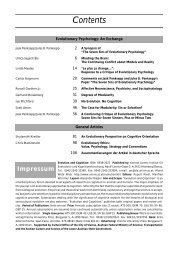Contents - Konrad Lorenz Institute
Contents - Konrad Lorenz Institute
Contents - Konrad Lorenz Institute
You also want an ePaper? Increase the reach of your titles
YUMPU automatically turns print PDFs into web optimized ePapers that Google loves.
Gestalt Experiments and Inductive Observations<br />
tions gained from animals kept in semi-natural conditions<br />
(1981, pp47ff). Thus TINBERGEN represented<br />
the ecological dimension of ethology more fully<br />
than LORENZ did. 1 Despite the fact that LORENZ was<br />
not a field naturalist, his approach was quite distinct<br />
from the American tradition of animal psychology<br />
and animal behavior studies. LORENZ often<br />
labeled the American scientists ‘behaviorists’, despite<br />
the fact that scientists such as John WATSON or<br />
Robert YERKES had quite different views of animal<br />
minds and behavior. But apart from theoretical differences,<br />
the American tradition was definitely<br />
characterized by laboratory studies. Observations<br />
and experiments under laboratory or controlled<br />
conditions dominated (WATSON 1914; YERKES 1925),<br />
field studies were an exception (e.g., WATSON 1908<br />
or YERKES’ student NISSEN 1931). This is due to the<br />
fact that in the United Studies animal behavior was<br />
studied at universities and institutes from early on,<br />
while some of the forerunners of European ethology<br />
were amateur naturalists. (In the United States,<br />
there were a few important field naturalist among<br />
the zoologists, rather than the psychologists. But<br />
even zoologists primarily studied behavior in laboratories;<br />
DEWSBURY 1988.)<br />
Ethological observations do not simply focus on<br />
specific aspects of animal behavior. Instead, according<br />
to LORENZ’s ideal ethological analysis start with<br />
considering all features of an individual including<br />
its natural environment (1981, pp52f). Observation<br />
has to give an overview of the complete behavioral<br />
system of a species (1948, pp221f). Only in this<br />
manner it is possible to obtain knowledge about the<br />
relevant substructures of the system, its functions<br />
and relations to other organisms and the environment<br />
(1950, p120). LORENZ calls this approach that<br />
tries to take all features into account an “analysis on<br />
a broad front”. It is justified by the fact that the object<br />
under study is a complex entity whose parts interact<br />
mutually. The chapter “The Organism as an<br />
Entity and Analysis on a Broad Front” of the Russian<br />
Manuscript (1948, pp137ff) gives a discussion and<br />
defense of this method (see also 1958, p249). To<br />
achieve this general overview of the whole behavioral<br />
complex of a species it is necessary to have a<br />
large observational basis that often may require<br />
years to obtain (1935, p109; 1948, p222; 1981, p48).<br />
Even before LORENZ, the naturalist Edmund Selous<br />
claimed that in his field notes he really wrote down<br />
everything he saw (BURKHARDT, forthcoming).<br />
While this is literally impossible, in particular the<br />
early practitioners in ethology are characterized by<br />
spending most of their time observing animals.<br />
Charles Otis WHITMAN, for instance, kept detailed<br />
notes of his extensive observations, and carried out<br />
observations for years before he published his results<br />
(LILLIE 1911). Like LORENZ, he emphasized that<br />
a detailed and extensive knowledge of the behavioral<br />
repertoire of a species is crucial to avoid false<br />
interpretations and conclusions (WHITMAN 1899a,<br />
1899b).<br />
The role of experiments within ethology is nicely<br />
illustrated by LORENZ’s and TINBERGEN’s classical<br />
study of the egg-rolling behavior of the Greylag<br />
goose (1938). (TINBERGEN was in fact the person who<br />
was more skilled in devising and conducting experiments.<br />
Compare TINBERGEN 1932, 1935, TINBERGEN/<br />
KUENEN 1939 with LORENZ’s more observational and<br />
theoretical papers LORENZ 1932, 1935, 1937.) On<br />
LORENZ’s account, experiments are to be preceded<br />
not only temporally, but also methodologically and<br />
logically by observations that are not goal-directed.<br />
For an experiment only makes sense if the natural<br />
units and their interaction are known to a sufficient<br />
degree (1981, p53). An encompassing observational<br />
basis is necessary to have a grasp of the structure<br />
and function of the system under consideration.<br />
Knowledge about the structure of organisms and<br />
the function of behavior is needed for having a biologically<br />
meaningful classification of the parts of<br />
the system studied. These elements identified by observation<br />
can one after the other analyzed in more<br />
detail and substantiated by experiments designed<br />
for addressing such particular questions (1935,<br />
pp110f). Thus, in the ethological approach, the experiment<br />
is necessarily posterior to observation.<br />
LORENZ is for instance impressed by the detailed<br />
observational work of the ornithologist Margaret M.<br />
NICE, and he states that one should always have<br />
such a detailed knowledge of an animal before one<br />
starts to conduct experiments.<br />
“Ich war begeistert von der Forschungsweise<br />
dieser Dame. So müßte man eben jedes Vieh kennen,<br />
bevor man mit ihm ‘Versuche’ anzustellen beginnt.”<br />
(LORENZ, letter to STRESEMANN, Blatt 94–97). 2<br />
The purpose of experiments is to analyze the subcomponents<br />
of an overall behavioral pattern (1935,<br />
pp105, 233; 1937, p293). The experiment enables<br />
one to keep the constitutive elements of behavior<br />
apart, and to study a largely dissociated component<br />
in detail. A certain experimental design allows the<br />
researcher to answer specific questions about the<br />
function of behavioral component and the causal<br />
relationship between the components. Dummy experiments<br />
serve to determine the specific stimulus<br />
that triggers an innate releasing mechanism and<br />
Evolution and Cognition ❘ 159 ❘ 2003, Vol. 9, No. 2








